A Walk on the Amazon River (Day 4 of 5) | Budget Adventure Travel
[Warning: Contains some photos and text that may not be appropriate for children of certain ages. Parental advisory is recommended]
Jan 01, 2012
Our morning adventure was a trek through the forest for 4 hours to learn about the various species that exist. But on the way we stopped by Anna’s habitat to see if she was up and about. Indeed she was out to bask in the morning sun.
Reportedly 8 meters length mid-age. You can see that it has undergone a dermal color transition from yellow spots (base) to dark black tone. If you look to the right of the photo at the rear of the snake, you can observe a slight bulge suggesting it had fed a large animal not too long ago. Takes them 3 months to digest a typical prey like caymans, land animals, monkeys. A human possibly. Who knows.
They continue to grow through their entire lifespan. While a lot of tourists come to the Amazon expecting to see Anacondas like as if they were like convenience stores around the corner, its rare to see them in the wild. And obviously dangerous for humans depending on the season.
To see a creature of such magnificent size and beauty feels at once both sheer terror and amazement. The fact is given it’s proximity to our boat, it just had to swing at any one of us, pierce its huge teeth and steel-like jaws in to the person, drag down in to the river, and asphyxiate till dead. Seeing it dormant like this makes you realize how fragile the human species are in reality. Indeed this creature is deserving of the awe and fear and respect that it commands.
Here is a video we managed to take just before it woke up and decided it had enough of the sun and pesky creatures staring it down and ventured back in to the trunk hole.
Our Austrian friends Andy and Stefie and our naturista Jairo (foreground).
Our first stop on the trek was the Cinchona tree, the famous medicine tree that contains Quinine, the main ingredient to fight Malaria. Amazing how the locals discovered a cure for Malaria before the western world even knew about Malaria.
This was amazing to see. The tree is not as tall as most others in the forest so it has to fight to obtain light. So over time when the foliage above grows so thick that it doesn’t receive enough light, it will start to grow new root branches towards the direction of strongest source of light and drop off existing root branches in the opposite direction. Thus the name ‘Walking Tree’. You can see in the photo above where a former branch had dropped of the trunk.
This tree (name unknown) produces a milky white sap which is edible. It is extracted and used in medicinal concoctions by the Shamans for various healing curatives.
A local concoction made by Shamans is called ‘Ayahuasca’ – it is a religious sacrament and not indulged for regular usage. It is known for its Hallucinogenic properties. Our naturalista told us how the drink is used under select conditions and only upon receiving approval of a local Shaman as it can cause severe dementia. The concoction is not available for public consumption though many tourists attempt of search for it. Some locals might offer it in return for some quick gain but tourists must take caution. DO NOT ATTEMPT TO INTAKE anything offered by locals without confirmation of your official guide.
This was another tree (name unknown) that has leaves on which one can write on as demonstrated above. They are indeed written upon by guides and locals for marking locations and pathways. Do you know what makes this writing possible on the leaf? Leave a comment with your answer. Ill be checking.
Both types of trees (names unknown) are locally referred to as the ‘changing tree’. The reason is in one species (on the left), the bark sheds in its entirety when covered with a local fungi that grows on it, while the other (on the right), shields its bark with the same fungi. The fungi plays critical symbiotic role. It needs a tree to grow on and thus in return in protects the tree from other insects. The fungus spore retains itself on the insects which will carry and spread the spores around the jungle. The insect will soon die of the fungus on its body. This is how the fungus spreads!! That is why Amazing comes from the word Amazon.
As cute as the frog may seem, it is one of the deadliest and most poisonous frogs in the forest (and probably in the world). The locals dab their hunting darts on the outside layer of the frog and then use it during real hunting. The little poison on the dart is enough to kill most large animals, including 2-3 humans with one dart!
A general rule of thumb is the more colorful the frog, the more lethal its poison. I wonder what the frogs would have to say about that if they saw Lady Gaga.
I had never seen a quicksand before. I would have never thought this to be one as it looks like solid ground. But the naturalista knows the terrain very well. Thus don’t venture in the jungle without a guide. We did walk over the the swamp, gently balancing ourselves on little tree logs that were floating on the surface.
No we did not eat it! Sheesh.
Amazon River Sunset taken on January 1, 2012 in Cuyabeno Reserve Ecuador. Was taken around 6:30 PM while sitting on the canoe in the middle of the lake surrounded by piranhas, caimans, and anacondas. This photo captures the juxtaposition of the beauty and tranquility of nature against the unseen dangers surrounding the photographer.
Spotted a Caiman after dusk on the way back. The way to find them is to shine your flashlight near the marshy areas, and look for a bright red spot. The red spot is the light flashing off their retina. Caimans are highly active at night.
Is that scary or what!
Related Posts
Category: Amazon Rainforest Adventures, Budget Adventure Travel, Ecuador Budget Travel



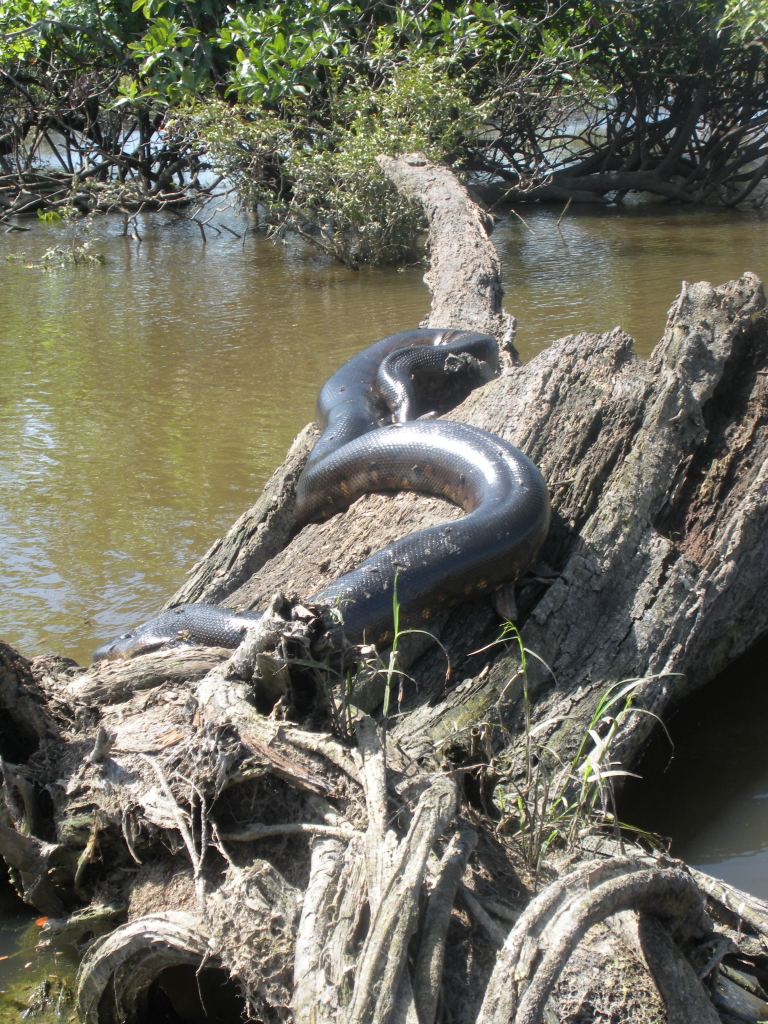










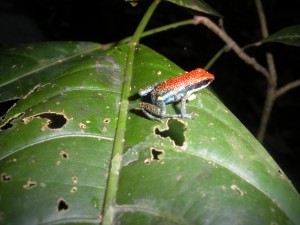

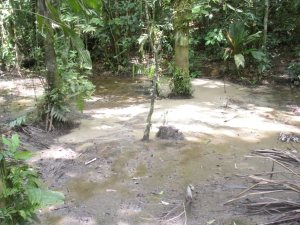
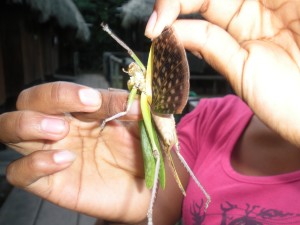



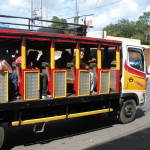

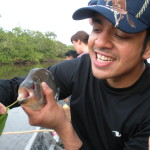
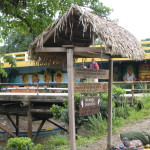
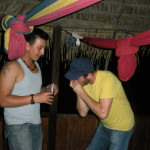
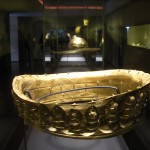











Having read this I thought it was extremely
informative. I appreciate you finding the time and energy to
put this information together. I once again find myself spending way too much time
both reading and commenting. But so what, it was still worthwhile!
Thank you for the kind words of appreciation.
@ Mike I know what your mean. In todays economy its difficult to find a job that pays well and is consistent. I have found that if you just work hard and are consistent you can succeed. Look at the writer of this article, they are clearly a hard worker and have just been consistent over time and are now enjoying at least what would appear as somewhat of a success. I would encourage everyone to just keep hustling and moving forward.